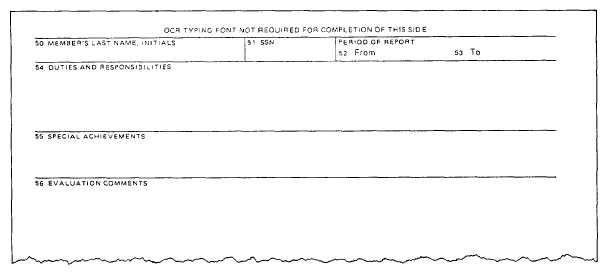Performance Evaluation Reports (figs. 2-8 and
2-9) with them. Then counsel them throughout
the evaluation period about their professional
growth and development.
When counseling, discuss the person’s specific
weaknesses and offer constructive suggestions for
improvement. Counsel persons who do a good
job, as well as those who don’t. Point out their
positive attributes, and let them know you appre-
ciate their efforts. That will motivate them to
continue doing a good job.
The current form consists of twelve evaluation
trait blocks divided into five distinct areas.
Professional factors are subdivided into military
knowledge/performance and rating knowledge/
performance. The personal traits area, divided
into five traits, provides an accurate personality
profile: initiative, reliability, military bearing,
personal behavior, and human relations. The self-
expression area contains an evaluation of the
person’s speaking and writing ability, which is
vital to advancement and interpersonal rela-
tionships. Leadership is subdivided into two
components—directing and counseling. A man-
agement block provides space for evaluation of
the management ability of enlisted personnel in
paygrades E-7, E-8, and E-9.
The revised report provides statements you
may use for evaluation comments by marking a
checkoff box; the former report required a written
statement in the comments area. The revised
report contains checkoff boxes for advancement
recommendation status and for recording percen-
tage of body fat. It also contains an area persons
being evaluated can mark to indicate they have
seen the evaluation report and understand their
rights under article 1122, U.S. Navy Regulations.
Special Performance Evaluation
Reports
Although the Enlisted Performance Evalua-
tion Report is an important management tool, it
is not the sole method of advising service members
of their performance. You may also use the
Special Performance Evaluation Report as an
effective counseling aid, especially for personnel
in paygrades E-1 through E-3. Give Special
Evaluation Reports frequently, whether positive
or negative, to provide a concrete input to the
person concerned. They provide a more meaning-
ful information base to superiors regarding
advancement recommendations, striker board
selections, and reenlistment recommendations.
Command Responsibilities
Commanding officers have responsibility for
the evaluation of all personnel assigned to them,
However, they normally delegate the authority for
making the initial evaluation to each person’s
immediate supervisor. The commanding officer,
through designated representatives, is responsible
for the accuracy, development, continuity, type,
and timeliness of the enlisted performance
evaluations.
Figure 2-9.—Enlisted Performance Evaluation Report (back).
2-11

